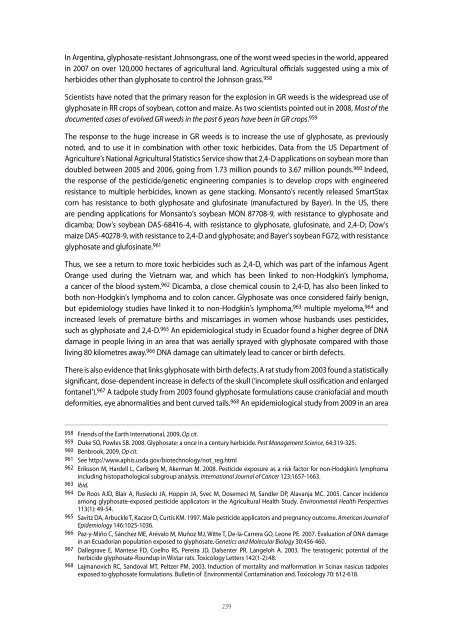CORPORATIONS
2dwWz4T
2dwWz4T
You also want an ePaper? Increase the reach of your titles
YUMPU automatically turns print PDFs into web optimized ePapers that Google loves.
In Argentina, glyphosate-resistant Johnsongrass, one of the worst weed species in the world, appeared<br />
in 2007 on over 120,000 hectares of agricultural land. Agricultural officials suggested using a mix of<br />
herbicides other than glyphosate to control the Johnson grass. 958<br />
Scientists have noted that the primary reason for the explosion in GR weeds is the widespread use of<br />
glyphosate in RR crops of soybean, cotton and maize. As two scientists pointed out in 2008, Most of the<br />
documented cases of evolved GR weeds in the past 6 years have been in GR crops. 959<br />
The response to the huge increase in GR weeds is to increase the use of glyphosate, as previously<br />
noted, and to use it in combination with other toxic herbicides. Data from the US Department of<br />
Agriculture’s National Agricultural Statistics Service show that 2,4-D applications on soybean more than<br />
doubled between 2005 and 2006, going from 1.73 million pounds to 3.67 million pounds. 960 Indeed,<br />
the response of the pesticide/genetic engineering companies is to develop crops with engineered<br />
resistance to multiple herbicides, known as gene stacking. Monsanto’s recently released SmartStax<br />
corn has resistance to both glyphosate and glufosinate (manufactured by Bayer). In the US, there<br />
are pending applications for Monsanto’s soybean MON 87708-9, with resistance to glyphosate and<br />
dicamba; Dow’s soybean DAS-68416-4, with resistance to glyphosate, glufosinate, and 2,4-D; Dow’s<br />
maize DAS-40278-9, with resistance to 2,4-D and glyphosate; and Bayer’s soybean FG72, with resistance<br />
glyphosate and glufosinate. 961<br />
Thus, we see a return to more toxic herbicides such as 2,4-D, which was part of the infamous Agent<br />
Orange used during the Vietnam war, and which has been linked to non-Hodgkin’s lymphoma,<br />
a cancer of the blood system. 962 Dicamba, a close chemical cousin to 2,4-D, has also been linked to<br />
both non-Hodgkin’s lymphoma and to colon cancer. Glyphosate was once considered fairly benign,<br />
but epidemiology studies have linked it to non-Hodgkin’s lymphoma, 963 multiple myeloma, 964 and<br />
increased levels of premature births and miscarriages in women whose husbands uses pesticides,<br />
such as glyphosate and 2,4-D. 965 An epidemiological study in Ecuador found a higher degree of DNA<br />
damage in people living in an area that was aerially sprayed with glyphosate compared with those<br />
living 80 kilometres away. 966 DNA damage can ultimately lead to cancer or birth defects.<br />
There is also evidence that links glyphosate with birth defects. A rat study from 2003 found a statistically<br />
significant, dose-dependent increase in defects of the skull (‘incomplete skull ossification and enlarged<br />
fontanel’). 967 A tadpole study from 2003 found glyphosate formulations cause craniofacial and mouth<br />
deformities, eye abnormalities and bent curved tails. 968 An epidemiological study from 2009 in an area<br />
958 Friends of the Earth International, 2009, Op cit.<br />
959 Duke SO, Powles SB. 2008. Glyphosate: a once in a century herbicide. Pest Management Science, 64:319-325.<br />
960 Benbrook, 2009, Op cit.<br />
961 See http://www.aphis.usda.gov/biotechnology/not_reg.html<br />
962 Eriksson M, Hardell L, Carlberg M, Akerman M. 2008. Pesticide exposure as a risk factor for non-Hodgkin’s lymphoma<br />
including histopathological subgroup analysis. International Journal of Cancer 123:1657-1663.<br />
963 Ibid.<br />
964 De Roos AJD, Blair A, Rusiecki JA, Hoppin JA, Svec M, Dosemeci M, Sandler DP, Alavanja MC. 2005. Cancer incidence<br />
among glyphosate-exposed pesticide applicators in the Agricultural Health Study. Environmental Health Perspectives<br />
113(1): 49-54.<br />
965 Savitz DA, Arbuckle T, Kaczor D, Curtis KM. 1997. Male pesticide applicators and pregnancy outcome. American Journal of<br />
Epidemiology 146:1025-1036.<br />
966 Paz-y-Miño C, Sánchez ME, Arévalo M, Muñoz MJ, Witte T, De-la-Carrera GO, Leone PE. 2007. Evaluation of DNA damage<br />
in an Ecuadorian population exposed to glyphosate. Genetics and Molecular Biology 30:456-460.<br />
967 Dallegrave E, Mantese FD, Coelho RS, Pereira JD, Dalsenter PR, Langeloh A. 2003. The teratogenic potential of the<br />
herbicide glyphosate-Roundup in Wistar rats. Toxicology Letters 142(1-2):48.<br />
968 Lajmanovich RC, Sandoval MT, Peltzer PM. 2003. Induction of mortality and malformation in Scinax nasicus tadpoles<br />
exposed to glyphosate formulations. Bulletin of Environmental Contamination and. Toxicology 70: 612-618.<br />
239


